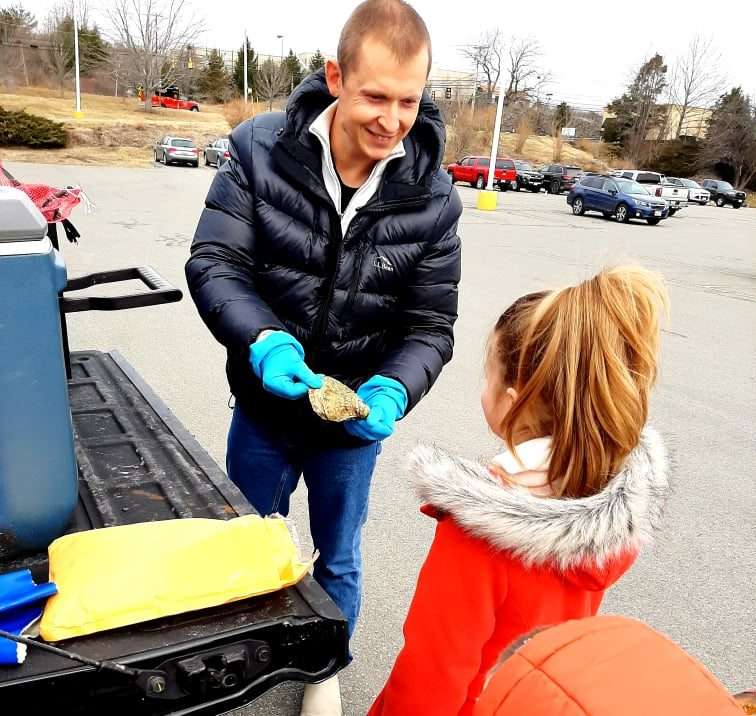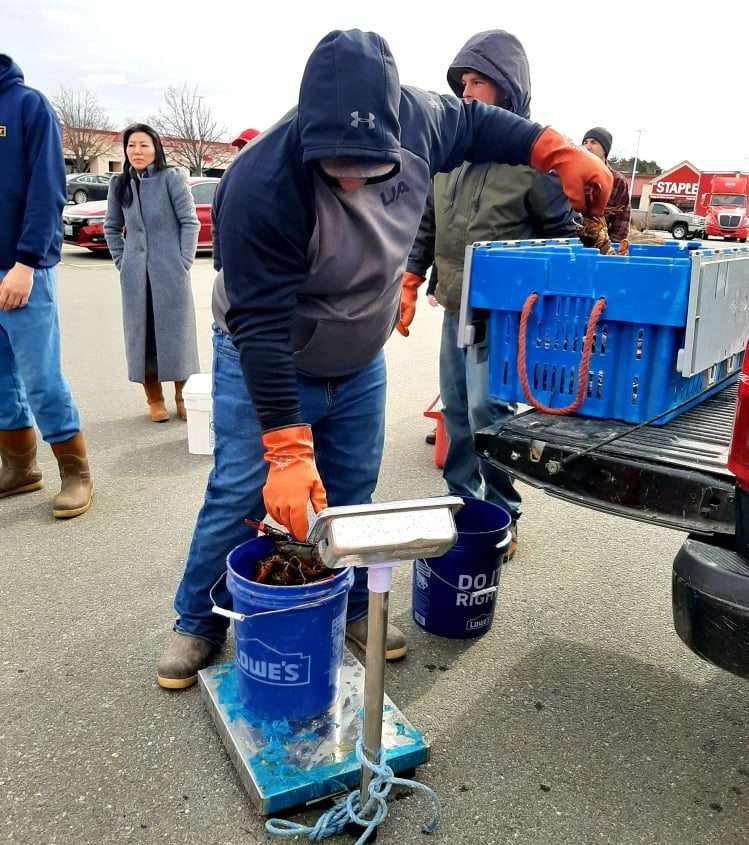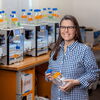
Maine fishermen turn to direct-to-consumer outlets
 Courtesy / Ali Farrell
Customers yesterday morning picked up seafood in Rockland from fishermen, through a new direct-to-consumer seafood outlet called Maine Seafood Connect.
Courtesy / Ali Farrell
Customers yesterday morning picked up seafood in Rockland from fishermen, through a new direct-to-consumer seafood outlet called Maine Seafood Connect.
Fishermen and seafood farmers are struggling with markets that have recently slammed shut. But over the past week, at least a few outlets have been established to connect the businesses directly to consumers.
A new Facebook group called Maine’s Working Waterfront-Seafood Connect began offering consumers the chance to pre-order lobster, oysters and other seafood. Two pick-ups have been held in Rockland.
“With so many seafood brokers currently shut down, this is your direct connect to the working waterfront and Maine's saltwater fishermen,” the group says in its Facebook feed. “With seafood distributors and restaurants closing their doors, we connect you with the fresh seafood you’re looking for at an ‘off the boat’ price.”
The format will shift March 28 to a farmer’s market format, allowing any licensed fishermen to sell product on a first-come, first-served basis. Fishermen will decide what and if they are selling each week. There will be no pre-orders.
Locations lined up so far are in the Staples parking lot in Rockland and the Renys parking lot in Belfast. Renys has offered to host pick-up sites at store spaces such as parking lots in Ellsworth, Camden, Belfast and Portland (which doesn't have a lot but details will follow). The markets will be held either Saturday or Sunday, at 10 a.m. Click here for updates.
Maine Coast Fishermen’s Association in Brunswick established a Facebook group called Maine Seafood Connection that allows fishermen and seafood businesses to post product they have for sale and local seafood consumers to find seafood.
“Please only sell product that is legal to be sold, that you have a permit to sell, and has been processed in a fully certified processing facility,” the page says.
2,000 oysters sold
Maine’s Working Waterfront-Seafood Connect was founded last week by Ali Farrell, a Camden author working on a book about women in the fishing industry.

“I became friends with people in the fishing communities,” she told Mainebiz. I was hearing about their troubles. Their market outlets are shut down.”
Farrell’s initial post, on her personal Facebook page for a friend who had lobsters to sell but no market, attracted about 100 replies, she said.
“So I put up a community page to let fishermen and consumers meet each other,” she said.
Over the past three days, over 1,000 pounds of lobster and about 2,000 oysters have been sold through the group, she said. The fishermen and consumers followed safety guidelines during the events, she added.
During the first delivery last Saturday in Rockland, consumers picked up 1,800 pre-ordered oysters from North Haven oyster farmer Adam Campbell in one hour.
Monday morning, Cushing lobsterman Travis Doughty and Dmitri Zaiets of Aphrodite Oysters in South Thomaston delivered about 30 pre-orders, with many customers coming from the Rockland-Camden area. One person came from Massachusetts. One drove from more than an hour north of Rockland.
“The demand is there,” Farrell said.
Farrell said she’s heard from about 700 people interested in the arrangement. The farmers market format is expected to make it simpler for fishermen and consumers to connect.
The fishermen set their own prices. However, Farrell is asking them to keep the prices at the “boat price,” which is the pre-markup price fishermen receive when they sell product to their dealer. At Monday's meet, lobsters sold at $5 per pound and oysters at $80 for 100 pieces or $1 per single oyster.
Adam Campbell, who sold the 1,800 oysters on Saturday, said the arrangement is worthwhile.
Abrupt crash
Campbell has owned North Haven Oyster Co. for 20 years and has a 20-acre lease site to farm his product. In typical times, sales range from 100,000 to more than 200,000 oysters per year to his Portland wholesaler. Twenty years ago, he said, buyers were mainly high-end restaurants in New York and other big cities. In recent years, Portland restaurants and retailers have absorbed all of his product due to its booming popularity.
Selling 1,800 oysters in one day is about the same amount he’d typically sell in a delivery to his Portland buyer, he said. The difference is that Saturday’s sales were made mostly through friends and family and a little bit of social media.
The market crash was abrupt, he said.
“About two weeks ago, the wholesale market completely evaporated,” he said. “I’ve been selling about 2,000 oysters per week. I made a drop-off on a Friday two weeks ago. I called them and said, ‘Are you ready for another batch?’ They said, ‘Nobody’s buying and all the restaurants are shutting down. It’s over.’”

Campbell is also a lobster fisherman and a state-licensed scallop fisherman.
“There’s no market for lobster,” he said.
The scallop market is still viable because the volume isn’t big, the season is short, and most sales go to the local community, he said.
Oysters keep growing
Oysters not sold keep growing, past their optimum size for the half-shell market.
“If we don’t move these oysters this summer in volume, they’ll continue to grow,” he said. “Once you start getting to 3 ½-, 4-, 4 ½-inch oysters, that’s too big. There’s a market for big oysters, but that market’s smaller than the half-shell market, which is what most farmers are doing.”
Campbell said his prices through the direct-to-consumer outlet, of $80 for 100 and $10 for a baker’s dozen, are wholesale.
“That’s what I’d normally sell them for to a dealer,” he said.
The direct-to-consumer model is a matter of survival for the industry, he said. It’s also helpful to consumers.
“People need food,” he said. “This is wholesome and it’s local. We shellfish farmers can produce by the millions.”
Hustle and innovation
More direct-to-consumer outlets will likely open up, said Maine Coast Fishermen’s Association’s executive director, Ben Martens.
“I think there’s demand for seafood,” he said.
Some markets, such as Harbor Fish in Portland, have implemented online ordering with curbside pick-up and local home delivery.
“I think we’ll see more of those businesses trying to create those connections,” he said.
The association’s Facebook group, Maine Seafood Connection, is designed to facilitate those connections, he added.
“We’re trying to create a space where consumers can connect with businesses,” he said. “We’ll see what comes of it. I think it will be a lot of hustle. But Maine is good at hustling. I think we’ll see a lot of innovation.”
State Rep. Genevieve McDonald, D-District 134, who represents Deer Isle and several islands, last week started a Facebook post at #seatotable, inviting harvesters to post their product, location and contact info; and consumers to post their location and the quantity they’re interested in buying.
“If you don’t see what you’re looking for, message me directly and I will connect you with a local fisherman,” she wrote.
The Maine Department of Resources yesterday posted on its website a link to a publication, "Guidance to Maine oyster farmers on selling your product in state,” compiled by the department, Maine Sea Grant, University of Maine and NOAA.
The publication includes information on how holders of a Maine aquaculture license and aquaculture lease can sell their shellfish, including selling off the farm and selling from home.
Mainebiz web partners
Who's selling in the Bath, Brunswick, Woolwich area?










2 Comments